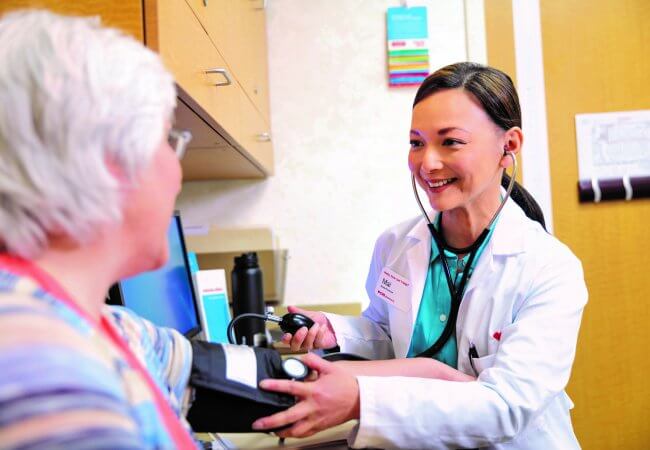
Aug 10, 2020
Nurse Practitioners Provide Age-Friendly Convenient Care

MinuteClinic is rolling out “Age-Friendly” care for its older adult customers. Credit: Courtesy of CVS Health
“What matters to you in terms of your care today?” This simple question is one nurse practitioners (and a few physician assistants) have begun asking older adults receiving care at MinuteClinic, the retail medical clinic of CVS Health.
It’s a question clinicians often fail to ask, focusing instead on the symptoms that prompt patients to seek care. But experts in caring for adults aged 65 and older believe knowing what matters to patients and understanding their health concerns in context will help streamline and improve care.
The Institute for Healthcare Improvement (IHI) calls these contextual factors the 4Ms—medication, mobility, mentation, and what matters—and has codified them in a framework called Age-Friendly Health Systems. The 4Ms Framework has been rolled out in hospitals and primary care clinics, and, in June, MinuteClinic began rolling it out in the convenient care sector.

Terry Fulmer, PhD, RN, FAAN, president of The John A. Hartford Foundation.
“We have got to connect the dots for older people, including at the pharmacy,” says Terry Fulmer, PhD, RN, FAAN, president of The John A. Hartford Foundation, which is dedicated to improving the care of older adults. Fulmer asked IHI to partner with the foundation on age-friendly care when she took the reins of that organization in 2015. As a nurse expert in the care of older adults, Fulmer was well acquainted with the unnecessary harm that can result from poor care transitions and had an ambitious vision to fundamentally transform geriatric care. That vision became Age-Friendly Health Systems, in which the 4Ms provide a common language that can “connect the dots” across settings and professional disciplines.
The 4Ms in Practice

Ann Lovegren, FNP-BC, provides age-friendly care at MinuteClinic in Portland, Maine.
Ann Lovegren, FNP-BC, is one of two providers at the MinuteClinic in Portland, Maine, which has the highest percentage of older adults of any U.S. state. As a result, Maine (along with Florida and Ohio) was a logical place for CVS to pilot the initiative. As a family nurse practitioner (NP) with additional geriatric training, Lovegren was eager to test out the 4Ms Framework. She says her approach has always been holistic and that she was alert to the cognition, mobility, and medication-related challenges of her older patients before implementing the framework. Nevertheless, she appreciates the structure the 4Ms provide. “What the system does is formalize what we already do here, and then it adds that piece about what matters to people, so that we are all directing our care in a way that aligns with the patient’s goals,” Lovegren says.
This past winter, Lovegren examined an 86-year-old woman who had first visited her two weeks earlier. At the initial visit, Lovegren had urged the patient to get her elevated blood pressure checked by her primary care provider. That proved to be easier said than done. Unable to get an appointment, the woman came back to the MinuteClinic when she experienced heart palpitations. Lovegren discovered her patient’s blood pressure was extremely elevated and instructed the patient’s son to take his mother to the emergency room. The visit might have ended there, but, with 4Ms care in place, the encounter continued with the woman explaining what mattered to her as she faced the prospect of hospital care. “I just need you to know that I don’t want any surgical intervention,” she told Lovegren.
Adapting the Framework for Retail Settings
To facilitate the use of the 4Ms in convenient care settings, The John A. Hartford Foundation awarded a grant to Case Western Reserve University in 2018. Associate Professor Mary Dolansky, PhD, RN, FAAN, and her colleagues at the Frances Payne Bolton School of Nursing used the award to adapt the 4Ms Framework for use in retail clinics. One major change: Dolansky and her team repurposed the framework’s mentation element. Used in hospital settings to emphasize delirium prevention, mentation prompts retail clinic providers to assess instead a patient’s mood and memory.

Mary Dolansky, PhD, RN, FAAN, adapted the 4Ms Framework to assist retail clinics in providing age-friendly care to older adults.
Dolansky is also director of the Quality and Safety Education for Nurses project. Working in collaboration with MinuteClinic, her team has created five online learning modules that MinuteClinic’s busy NPs and physician assistants can complete in short intervals. Using a gaming platform, the team has also designed a virtual clinic where MinuteClinic providers can practice integrating the 4Ms into a virtual patient visit.
While at work, providers receive ongoing feedback through an online clinic dashboard. The integration of the 4Ms into MinuteClinic’s electronic health record will be key to the framework’s success, in Dolansky’s view. She says, “Most practice changes occur because of technological enhancements,” a conclusion she reached while participating in an IHI collaborative learning community.
A Business and Social Investment

Anne Pohnert, MSN, FNP-BC, director of clinical quality, oversees MinuteClinic’s age-friendly care initiative.
Why is CVS making the commitment to provide age-friendly care? “Our purpose across the CVS enterprise is helping customers on their path to better health,” says Anne Pohnert, MSN, FNP-BC, director of clinical quality at MinuteClinic. CVS has another incentive as well, having recently acquired health insurer Aetna. “We ultimately want to look at longitudinal cost savings by identifying and addressing cognitive, medication, and other issues earlier,” Pohnert says.
Fulmer was eager to partner with MinuteClinic because, in her view, “They are unleashing the power of advanced practice nursing,” a priority shared by the Campaign for Action. Of equal importance, Fulmer believes the collaboration will advance what she calls the Age-Friendly Health System social movement. “When 1,100 MinuteClinics declare themselves age-friendly,” she says, “the country will notice.”
Fulmer hopes the foundation’s investment will eventually influence care throughout the retail clinic sector and beyond. Other entities and individual nurses anywhere in the world who want to incorporate the 4Ms into their practice may do so using the free guidance available on the IHI website.
Building a Bridge to Primary Care
Retail clinics have demonstrated their value in multiple ways. They are widely accessible, provide evidence-based care, and offer transparent and affordable pricing. But they remain at a disadvantage in one key area: continuity of care. MinuteClinic can share information with providers that use the same electronic-health-record vendor, but typically the onus is on patients to convey what happens in convenient care settings to their primary care or other providers. Dolansky hopes the 4Ms Framework will help mitigate this problem.
Her team has created an after-visit summary they call a brochure. It has spaces where providers can note what needs to be conveyed to other providers about each of the 4Ms. “We believe that handing the patient this brochure will help cue them to take action and share it with their primary care provider,” Dolansky says.
Lovegren agrees. She says primary care providers in her community are overburdened and often refer their patients to MinuteClinic for routine care. She believes the 4Ms will “strengthen that bridge to primary care.”
In February, after hearing her patient’s remark about not wanting surgery, Lovegren talked with the woman and her son about end-of-life care. Then she documented the patient’s wishes in the electronic health record for her other health care providers. “When my clinic partner followed up by phone the next day,” Lovegren says, “the patient was really grateful. She basically felt we had saved her life.”
